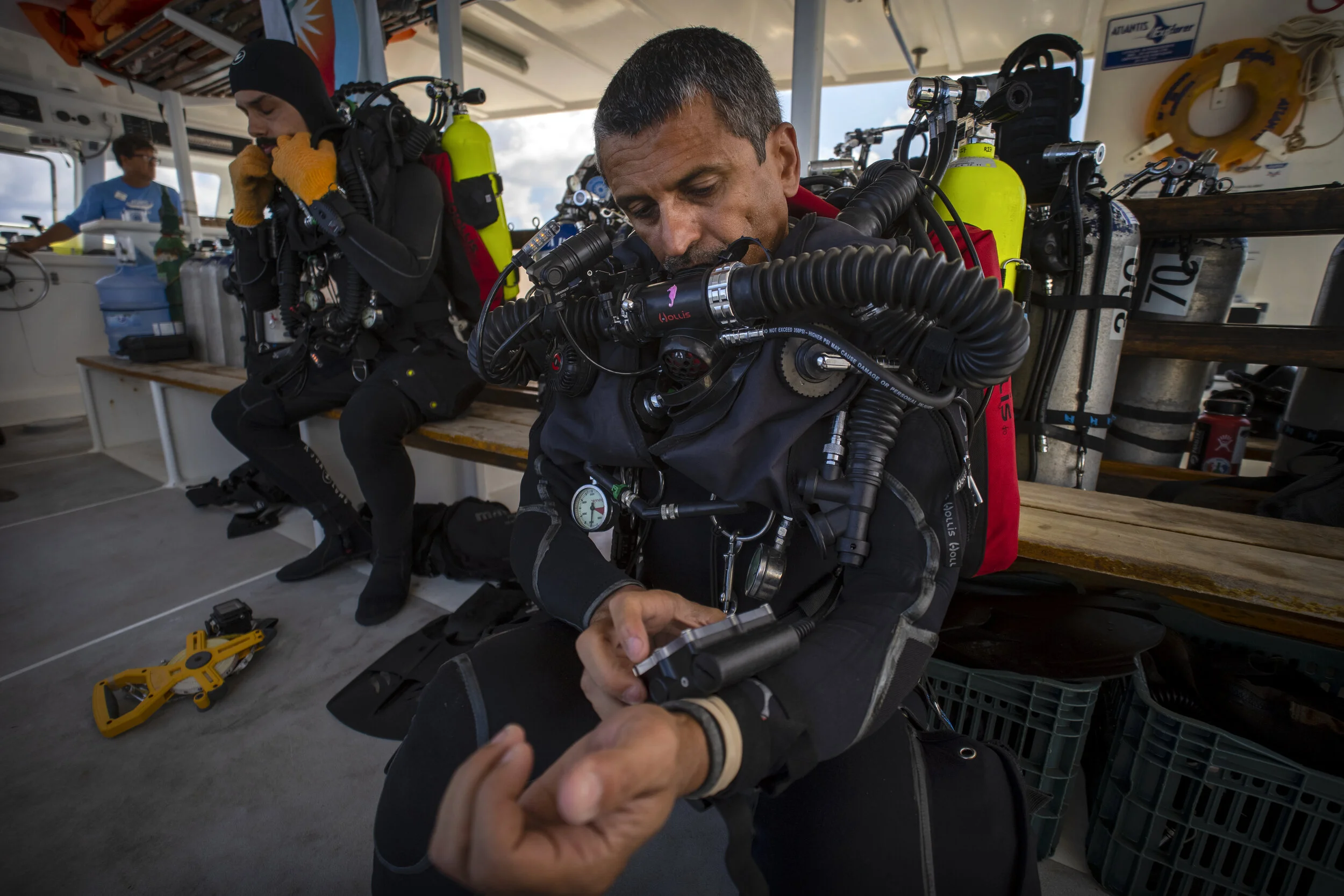"For the Love of Reefs"
“For the Love of Reefs” as featured in Oceanographic Magazine
By Justin Grubb
Fernando de Noronha, Brazil
“It's a little bit depressing at times when we get to a place and we see the ecosystem that we love and grew up with dying in front of our very eyes, but for the most part, this has been very rewarding.”
Our research vessel rocked back and forth in moody seas off the coast of Fernando de Noronha - a volcanic island nearly three hundred miles east of Brazil. The view from our starboard side included the expansive Atlantic Ocean, which contrasted with the crashing waves and hundred-foot cliffs on our port side. Below us, were hundreds of feet of open ocean. The hisses of regulators and clunking of tanks dominated the soundscape as the team prepared their gear for the long dive ahead.
The expedition was undertaken in pursuit of a larger mission to reverse the trend of extinction for reefs all over the world. An initiative called “Hope for Reefs” is the driving force behind this mission. It’s led by the California Academy of Sciences - a research institute and natural history museum in San Francisco, California. With nearly 75 percent of the world’s reefs threatened by overfishing, habitat destruction, water pollution and climate change, the academy sends teams of scientists out to descend to unexplored depths of the ocean to learn what it takes to save this valuable habitat.
With every expedition, the team of six travels to some of the world’s most remarkable reefs and Fernando de Noronha is no exception. With its picturesque clear blue water, white sandy beaches and stunning topography, this island not only serves as a destination for tourists but a haven for ocean life. The biggest industry on the island is scuba diving as visitors flock from around the world to get up close to the wildlife that has benefited from the protection of the Fernando de Noronha National Marine Park, established in 1988. The park, however, mostly encompasses shallow reefs, only affording protection for smaller fish species and animals that wander into its waters.
Beyond these shallows, lies a completely different and unprotected ecosystem called the mesophotic reef. This habitat is from 100 to 500 feet in depth and contains unique coral and fish species that are as vulnerable to exploitation as shallow-reef marine life. Throughout the world, these deeper reefs are often ignored when establishing new protected areas because they are not seen as being as vulnerable. The California Academy of Sciences visited Fernando de Noronha with help and funding of Fundação Grupo Boticário to study its deep reefs and to collect data that they hope can be used to expand the marine protected area with the help of the Brazilian government. The local government has taken great strides in conservation practices by limiting the number of tourists on the island, banning the importation of plastic by visitors and by applying a hefty daily visitation fee to support continued environmental protection.
As the voice of the dive safety officer carried the team through their pre-dive checklist, Luiz Rocha, Associate Curator and Follett Chair of Ichthyology at the California Academy of Sciences, lifted his head and pointed to a small fishing boat between us and the towering cliffs. “See that?’ he said to me, nodding with his head. “That boat is fishing in protected waters; we are on the edge of the reserve right now.” A quick radio call to the proper authorities followed, but the team remained focused on the dive.
Luiz is a Brazilian native and grew up along the coast where he explored the sea as a kid. There, he had an extensive collection of live marine organisms in aquariums where he replicated their ecosystems to study their husbandry. This is where Luiz found his love for the ocean, and as time went on, his drive to protect it. “It is a little bit depressing at times when we get to a place and we see the ecosystem that we love and grew up with dying in front of our very eyes, but for the most part, this has been very rewarding.” Luiz made this remark as he reflected on being back in Brazil to conduct this valuable research and on what the team had accomplished thus far. Through the Hope for Reefs initiative, Luiz and his team have been on more than 16 expeditions since 2016 and have discovered a handful of new species that aid in developing new conservation strategies.
On the boat, Luiz pushed his weight off the front of the bench, dipping his body down to slip on his rebreather that is decorated in sea animal stickers. He then lifted the whole system over his head and sat up as the rebreather fell into place. As he completed this maneuver, the team, one by one, dove off the boat and slowly disappeared into the dark blue water below.
My role in this expedition was to document the scientific undertaking in Fernando de Noronha and highlight the work of the California Academy of Sciences. As a wildlife filmmaker with a background in marine biology, I found this particular expedition to be exciting. Three hours into the dive, it was my turn to jump in and join the team. As I followed their surface marker buoy line down, I could see everyone hard at work laying out transects and collecting fish. As we explored the vertical volcanic walls, an incredible diversity of ocean life surrounded us. Large schools of pelagic fish swam by to check us out as smaller gobies and damsels darted into the cracks and crevices, wary of our approach. Sharks, octopus, turtles, and eels regularly accompanied us on our dive. As we wrapped up this mission and broke the surface, the team finally began to show their excitement about what had been collected during the dive. Bart Shepherd, Director of the Steinhart Aquarium in San Francisco, presented me with a small container of fish. The team believed the fish within were a new species that could aid in laying the groundwork for extending the Fernando De Noronha National Marine Park. In high spirits, we motored back to shore.
To learn more about what a potential expansion of the marine park might mean for the region, I met with one of many local fishermen. Fishing is the second largest industry on the island. The fisherman I talked to was friendly to the efforts of the Hope for Reefs initiative as he himself provided support for the research team throughout the expedition. He stood by the decisions of local environmental authorities to restrict the use of harmful fishing methods such as using gill nets and long lines. However, he raised some concerns about expanding the marine park. He fears, by extending the marine park even further, fishermen will have trouble making ends meet. The fishing restrictions put into place already cause greater competition among fishermen. In addition, when the weather is poor on the open-fishing side of the island, fishermen lose a day of productivity as they are unable to maneuver to the other side of the island and fish due to its protection status. For now, fishermen and environmental authority relationships remain peaceful and collaborative.
To get an idea of how local government authorities balance the delicate intricacies of conservation, community and economy, I met with the main environmental authority on the island to conduct a quick interview. This individual has been instrumental in allowing the research expedition to occur and has been very supportive of our efforts. Standing on a crowded road along the busy harbor, I went over the questions I was hoping to ask him and the conditions that would allow me to film. After agreeing to appear on camera, he then changed his mind and wished to do an audio interview only. This way, he felt more comfortable answering my questions. As I prepared my equipment, some heavy discussion broke out amongst him and his group and ten minutes later, he decided not to go through with the interview. He described his fear of severe retaliation by the government of Brazil for voicing his opinions on the importance of conservation. Recently, the government has backtracked on environmental protection policies and refuses to acknowledge climate change as a global threat as evidenced by the recent fires in the Amazon rainforest.
Despite the overwhelming challenges, Luiz and his team remain optimistic and believe there is a bright future ahead for our oceans. “There is a lot of hope,” he said as he referenced an earlier expedition to the Marshall Islands. “Bikini Atoll was literally nuked 50 years ago, but today supports a great population of healthy fish and corals due to their protection. All you need to do is leave it alone and it will recover.”
There is still a year of expeditions planned for the current phase of the Hope for Reefs initiative. After Brazil, the team heads to the Indian Ocean to explore the Maldives. Luiz’s face lit up as he described his next trip. “The Indian Ocean is a place we have always wanted to explore because everywhere we go is unexplored from a scientific perspective.” In this new frontier, the goals are similar: explore deep reefs and describe new species that can aid in the development of new conservation management strategies. Luiz feels that the Hope for Reefs initiative has been very successful and looks forward to continuing his work in exploring and protecting the ocean. To learn more about the Hope for Reefs Initiative and to see past expedition results, visit www.calacademy.org/major-initiatives/hope-for-reefs.









